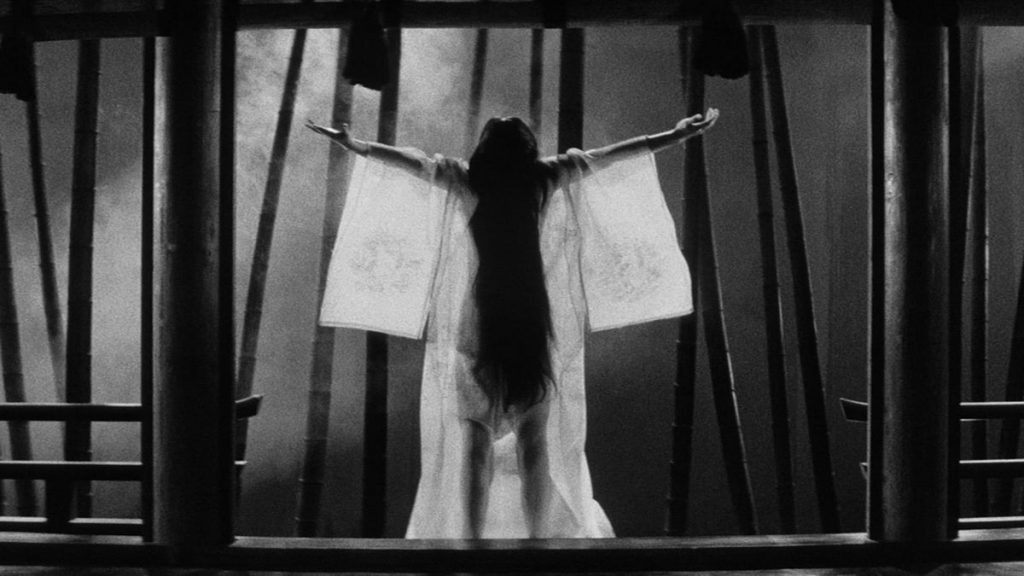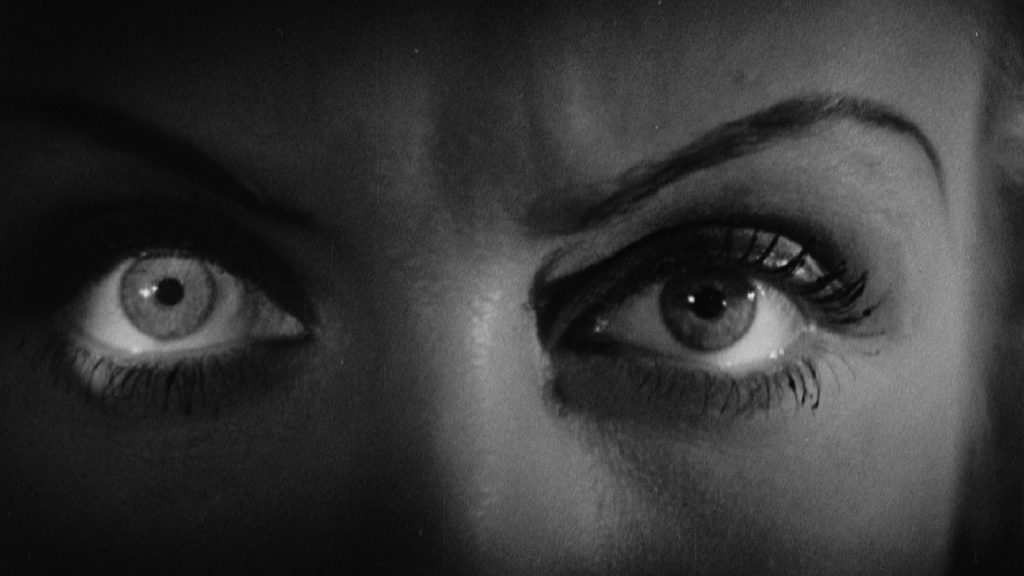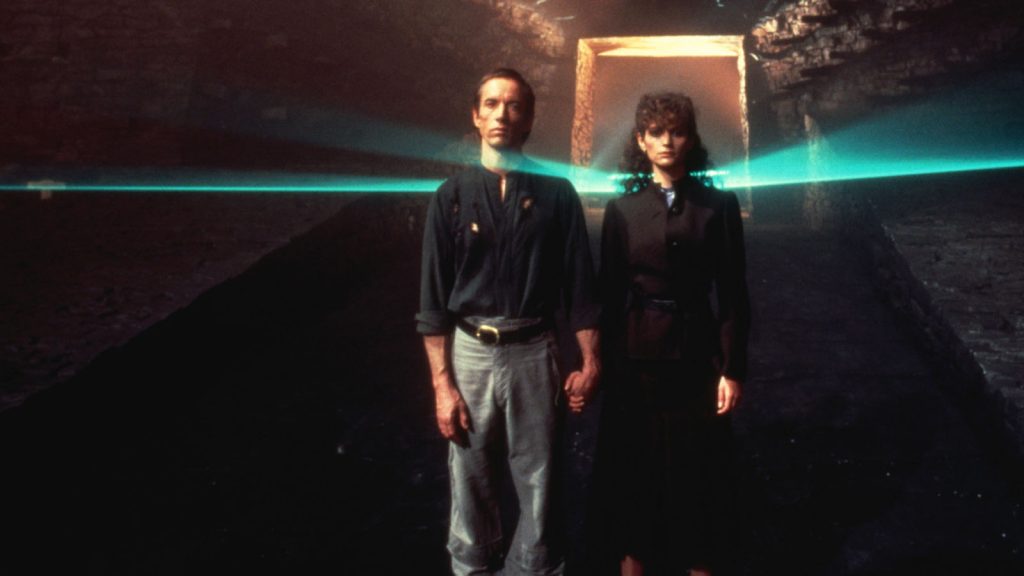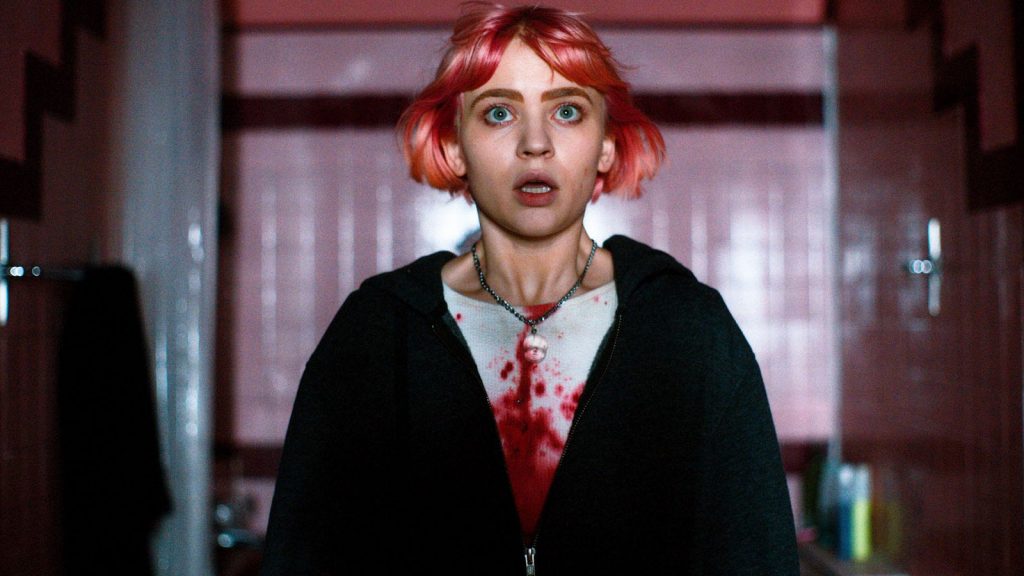A swarm of samurai emerge from a bamboo grove in firefly patterns, arriving at the threshold of a humble hut. The scene is nearly silent, false tranquility preceding a torrent of savagery. The samurai enter the hut, which is occupied by the widow Yone (the amazing, transfixing Nobuko Otowa) and her daughter-in-law Shige (Kiwako Taichi). The women have resided there alone ever since Hachi (Kichiemon Nakamura), Yone’s son and Shige’s husband, was conscripted into a local warlord’s infantry. The samurai devour the available food and drink, then turn to the women, raping them, leaving them for dead, setting their home ablaze. The following morning, we see the hut’s smoldering remains, its skeletal frame, and the women’s lifeless bodies laid out like an offering upon a bed of ash and cinder, their flesh barely charred, their robes intact. They are visited by a black cat, who licks at their still-wet wounds.
The opening sequence alone secures Kaneto Shindo’s Kuroneko (1968) a place in the pantheon of Japan’s most chillingly exquisite horror films. Like Shindo’s equally indelible Onibaba (1964), Kuroneko—which translates as “black cat”—is set during Japan’s Sengoku, or Warring States, period that spanned the 15th to 17th centuries and centers around two rural women who, driven by forces carnal or supernatural, come to prey upon men. In the case of Kuroneko, our protagonists are posthumously transformed into shape-shifting creatures—sometimes human, sometimes feline, sometimes phantasmagorical—luring samurai into their wood-shrouded home, where they exact their revenge. The pattern continues until, some years into their campaign, they are confronted by an incident of dramatic irony that I’ll leave the uninitiated to discover.
Harnessing a style at once stark and expressionistic, Shindo and cinematographer Kiyomi Kuroda illuminate some scenes so sparingly that the only things visible are two or three characters and a handful of isolated surfaces, just enough to indicate the nature of a given setting. We could be witnessing theater, opera, or dream—or poverty-row noir, though the oneiric minimalism of a film like Detour (1945) was forged out of necessity, whereas Kuroneko surely came to its carefully honed aesthetic by choice. There are abrupt shifts in the soundtrack, with dramatic music plunging into soundlessness. Much of the visual design is vertical: billowing drapery, spindly trees, or the pillars of Rashomon Gate, which separate Kyoto from the dark, enchanted countryside. The characters also turn vertical, leaping, scaling, flying. There are visions we can’t quite be sure how to register—ghosts appear then quickly recede like a departing train; we catch a glimpse of a weirdly hirsute arm—and there are moments of sudden, breathtaking violence. Kuroneko inaugurated or perfected tropes that haunt Japanese horror to this day, while its equation of cats with hedonism and murder harkens back to ancient beliefs across many cultures. Which is to say the film is genuinely timeless, its core fears and desires drawing upon something primal that evades domestication. Meow.

is a freelance critic and playwright.
The opening images of Kaneto Shindo’s exquisite, dread-drenched, medieval Japan–set Onibaba (1964) are overlaid with telegraphic fragments of text: “THE HOLE. DEEP AND DARK…”
BY JOSÉ TEODORO | November 15, 2024
Consider the Dies Irae. Eight dire notes to remind you that you are going to die.
BY TOM PHELAN | July 26, 2024
Despite what’s tantamount to a subgenre of macabre offerings suggesting otherwise, Edgar Allan Poe isn’t an author whose work readily lends itself to the cinematic medium. He’s very much an “on the page” writer...
BY COLIN FLEMING | November 2, 2025

This pre-Code offering packs a lot of story into its typically brisk running time, with several plot threads weaving together a (not always successful) tapestry of spooky and criminal doings.
READ MORE >
BY ANN OLSSON | Month 00, 2021

In what could be the fastest-resulting rape revenge movie, a drunken lout brutally forces himself on Ida, the young woman who doesn't return his affections, during a party over Labor Day.
READ MORE >
BY LAURA KERN | Month 00, 2021

Beast is a lot of movies in one package - fractured fairy tale, belated-coming-of-age story, psychological drama, regional horror film - but above all it's a calling card for its leading lady, Jessie Buckley.
READ MORE >
BY LAURA KERN | Month 00, 2021